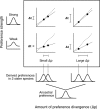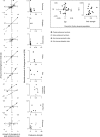Diversification under sexual selection: the relative roles of mate preference strength and the degree of divergence in mate preferences
- PMID: 23809185
- PMCID: PMC3757319
- DOI: 10.1111/ele.12142
Diversification under sexual selection: the relative roles of mate preference strength and the degree of divergence in mate preferences
Abstract
The contribution of sexual selection to diversification remains poorly understood after decades of research. This may be in part because studies have focused predominantly on the strength of sexual selection, which offers an incomplete view of selection regimes. By contrast, students of natural selection focus on environmental differences that help compare selection regimes across populations. To ask how this disparity in focus may affect the conclusions of evolutionary research, we relate the amount of diversification in mating displays to quantitative descriptions of the strength and the amount of divergence in mate preferences across a diverse set of case studies of mate choice. We find that display diversification is better explained by preference divergence rather than preference strength; the effect of the latter is more subtle, and is best revealed as an interaction with the former. Our findings cast the action of sexual selection (and selection in general) in a novel light: the strength of selection influences the rate of evolution, and how divergent selection is determines how much diversification can occur. Adopting this view will enhance tests of the relative role of natural and sexual selection in processes such as speciation.
Keywords: Diversification; mate preference function; sexual coevolution.
© 2013 The Authors. Ecology Letters published by John Wiley & Sons Ltd/CNRS.
Figures






References
-
- Andersson M. Sexual Selection. New Jersey: Princeton; 1994.
-
- Arnegard ME, McIntyre PB, Harmon LJ, Zelditch ML, Crampton WGR, Davis JK, et al. Sexual signal evolution outpaces ecological divergence during electric fish species radiation. Am. Nat. 2010;176:335–356. - PubMed
-
- Arnqvist G. Comparative evidence for the evolution of genitalia by sexual selection. Nature. 1998;393:784–786.
-
- Bailey NW. Love will tear you appart: different components of female choice exert contrasting selection pressures on male field crickets. Behav. Ecol. 2008;19:960–966.
-
- Boughman JW. Divergent sexual selection enhances reproductive isolation in sticklebacks. Nature. 2001;411:944–948. - PubMed
Publication types
MeSH terms
LinkOut - more resources
Full Text Sources
Other Literature Sources
Miscellaneous

